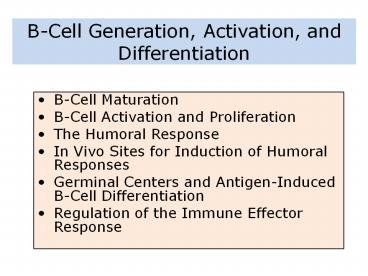B-Cell Generation, Activation, and Differentiation - PowerPoint PPT Presentation
1 / 35
Title:
B-Cell Generation, Activation, and Differentiation
Description:
B-Cell Generation, Activation, and Differentiation B-Cell Maturation B-Cell Activation and Proliferation The Humoral Response In Vivo Sites for Induction of Humoral ... – PowerPoint PPT presentation
Number of Views:2542
Avg rating:3.0/5.0
Title: B-Cell Generation, Activation, and Differentiation
1
B-Cell Generation, Activation, and Differentiation
- B-Cell Maturation
- B-Cell Activation and Proliferation
- The Humoral Response
- In Vivo Sites for Induction of Humoral Responses
- Germinal Centers and Antigen-Induced B-Cell
Differentiation - Regulation of the Immune Effector Response
2
Naïve B cells are short-lived
Class switch Affinity maturation
Ab
10
Chap. 11
Chap. 11
Chap. 5
Chap. 11
3
Committed Lymphocyte Progenitor
Adhesion molecules
4
Progenitor B cells
Proliferative signal
5
Precursor B cells
Proliferation and development
6
Rearrangement of Immunoglobulin Genes during B
cell Development
7
The pre-B cell receptor complex Membrane heavy
chain ? associates with surrogate light chain
(Vpre-B and a C-like sequence, ?5). This
associates with the Ig-?/Ig-? heterodimer.
Signaling complex
8
(No Transcript)
9
(No Transcript)
10
(No Transcript)
11
Fig. 5-17
12
(No Transcript)
13
(No Transcript)
14
(No Transcript)
15
B-1 B cells
- Innate-like subset of B cells.
- Appear during fetal life and express IgM but
little IgD and display CD5. Are also found in
peritoneum. - Originates from stem cell in bone marrow, but
also from proliferation of B-1 cells outside the
BM. - Responds poorly to protein antigen, but strongly
to carbohydrate antigens. - Antibodies produced are of low affinity.
16
- Self-reactive B cells are eliminated in bone
marrow (BM). - BM produces 5 x 107 B cells/day, but only 5 x 106
B cells/day or 10 actually enter the
circulation. - Some of this loss is due to negative selection
and elimination or clonal deletion of immature B
cells expressing autoantibodies to self-antigens.
17
Experiment by D.A. Nemazee and K. Burki (1989)
demonstrated negative selection of B cells
DNA encoding IgM specific for H-2Kk, a class I
MHC molecule
Mice were H-2d or H-2d/k
18
- Endogenous H-2k and H-2d class I MHC molecules
are present on bone marrow stromal cells of
transgenic mice. - Transgenic B cells will express anti-MHC Kk IgM
antibodies.
19
(No Transcript)
20
(No Transcript)
21
anti-Kk IgM
Total IgM
61.6 of IgM antibody
Membrane IgM
22
There is negative selection against any immature
B cell expressing auto-antibodies on their
membranes because these antibodies react with
self-antigens present on stromal cells, leading
to crosslinking and death of the B immature B
cells.
23
- Tiegs and Nemazee (1993) demonstrated that
self-reactive B cells can be rescued by
expressing an edited light-chain gene. - Found that a few mature B cells in the H-2d/k
transgenic mouse expressed the transgene encoded
? chain but a different light chain.
B cell maturation is arrested
24
B cell activation
- Depending on antigen, B-cell activation proceeds
by two different routes. - Thymus-dependent (TD) antigens require direct
contact with TH cells to activate B cells. - Thymus-independent (TI) antigens can activate
B-cells in the absence of TH cells.
25
- Thymus independent (TI) antigens are divided into
two types, 1 and 2, and activate B cells by
different mechanisms - Most TI-1 antigens are polyclonal B-cell
activators, or mitogens, for example, LPS. - TI-2 antigens work by crosslinking the mIg
receptor. - TI-2 are different from TI-1 in three ways.
- Are not B-cell mitogens.
- Activate only mature B cells and inactivate
immature B cells. - Cytokines from TH cells are required for
proliferation and class switching.
26
(No Transcript)
27
Progression
G0
Competence Signals
28
Transition of lymphocytes from G0 into S (cell
cycle), requires two steps - competence and
progression. Competence requires signal 1 and
signal 2. Progression requires interaction with
cytokines and other ligands with receptors on the
B cell membrane
Competence Signals
Signal 1
Signal 2
29
Signal 1 gt Antigen binding the B cell receptor
(BCR) associated with Ig?/Ig? heterodimer. Signal
2 gt Interaction between CD40 on the B cell and
CD40L on the activated helper T cell.
30
Lyn
BCR
31
Lyn
BCR
32
Similar to T cell receptor signaling
33
4
2
1
5
3
- Compartmentalization.
- Activation by receptor-mediated PTKs.
- Assembly of signaling complex.
- Recruitment of other signaling pathways.
- Changes in gene expression.
7
8
9
34
CD22 (resting B cells) delivers a negative signal.
Amplification
35
Effects of co-receptors on BCR signals.
- Without coreceptors, more molecules of IgM need
to be engaged for B-cell activation. - Mice immunized with a C3d-antigen fusion protein
developed a stronger immune response. - CD19 knockout mice had greatly diminished
responses to most antigens.

